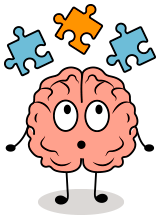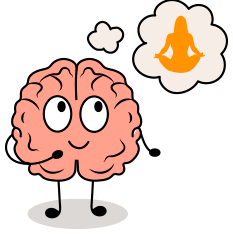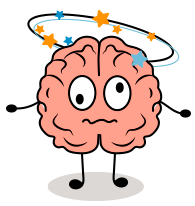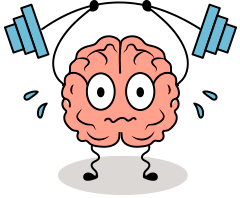How to manage panic attacks, stress, and social anxiety? The first step is understanding the why of your suffering, whether panic attacks, anxiety disorders, or social anxiety. What are the actual causes or triggers within you? Next, learn how to overcome these triggers and live a more calm and centered life when you discover the types of meditation—the physical, mental, and emotional health benefits and which type of meditation is right for you.
What Are Panic Attacks
Panic disorder is a common mental health problem. It often starts in the teens or early adulthood but may also begin in childhood. Women are twice as likely to suffer from a panic disorder than men.
My panic attack disorder started when I was thirteen, and I remember the first one like it was yesterday—walking into the school from lunch break. I felt like the walls were closing in on me, my head was spinning, and my chest was so tight it felt like the air was choking me. My heart was pounding like a jack rabbit, and I went down on my hand and knees in freeze mode. I honestly thought I was going to die!
The Root Cause Of My Panic Attacks
I grew up in an abusive alcoholic home where my father would come home and wreck the place and beat my mother. He would like when the urge came up to pull my older siblings from their beds in an abusive manner; I had seven siblings at the time—terrorizing the whole family. Then, the painful loss of one of my older brothers at 34 from liver failure from alcoholic abuse. Then, more pain and grief losing another brother at the age of 43 to a heart attack; he drank, did any drugs that would numb his emotional distress, and began cutting himself at 14. Cutting himself was so horrific; he told me once that when I pleated for him to stop, he said the pain made him feel better, which means that the physical pain lessened his emotional pain.
Social Anxiety Disorder
My panic attacks grew in frequency, and it came to the point by the time I was in my twenties, I had them daily. After that, I avoided social events at all costs; even going to the grocery store was a waking nightmare at times. I was always in fear, wondering when the next one would come. Being around people was the last place I wanted to encounter; I became a prisoner in my own home.
Finding the WHY, the conscious or subconscious reason we suffer from fear, stress, and panic disorders, is crucial for healing.
Millions of People Suffer From Panic Disorders
The National Institute of Mental Health (ADAA, 2020) statistics for adults suffering from an anxiety disorder is 6.8 million, so if you feel alone, you’re not.
According to the (ADAA 2020) Anxiety and Depression Association of America, Six million adults have panic disorders.
According to the National Institute of Mental Health (NIMH, 2017), generalized anxiety disorder (GAD) is the most common. Individuals who suffer (from GAD) have symptoms of anxiety lasting for six months with very little to provoke the onset. As a result, for individuals who suffer from (GAD), their home, social, and work-life begin to be affected.
Anxiety Symptoms Include
- Difficulty focusing or confusion
- Excessive feelings of worry that are difficult to control.
- Sleep issues
- Feeling restless or on edge
- Often feeling fatigued
Anxiety-Related Disorders
Individuals with panic disorder suffer panic attacks that are unexpected or repeated. As a result, individuals with panic disorders will avoid certain situations and experience constant worry about the next one.
Symptoms:
- Feelings of loss of control
- Feelings of terror
- Shortness of breath
- Health palpitations or racing heart rate
- Sweating or chills
- Shaking and trembling
Post-traumatic Stress Disorder
Post-traumatic stress disorder (PTSD) occurs when the individual struggles to recover after a traumatic life event. Therefore, a wide variety of PTSD symptoms may appear in the individual’s life months or even longer after the traumatic event occurred.
Symptoms include:
- Nightmares about the event
- Out of Control Fight or Flight Response
- Flashbacks
- Unwanted and recurrent memories that cause distress.
- Avoid people, places, and situations that remind them of the event.
- Feelings of the hopelessness of the future.
How Common are Anxiety Disorders? Adult Anxiety in the United States
Forty million adults are affected by anxiety, the most common mental disorder. (ADAA, 2020).
Fifteen million adults suffer from social anxiety.
7.7 million have PTSD (ADAA, 2020).
6 million have panic disorders, and 6.8 have generalized anxiety (ADAA, 2020)
(ADAA, 2020), women are twice as likely to have generalized anxiety as men. Anxiety disorders affect 23% of female adults and 14% of males. OCD affects 2.2 million adults; women and men are equally affected (ADAA, 2020)
Risk Factors for Anxiety
Anxiety risk factors may include low self-esteem, especially in young people, and can indicate stress.
Increased stress, therefore stress, and anxiety can come from many sources. In addition, lifestyle and environmental factors add to stress and anxiety in individuals of all ages.
Examples:
- Health conditions
- Sleep disorders
- Life situations such as,
- Work problems
- Financial issues
- School stressors
- Relationship issues
- The death of a loved one
- Traumatic events experienced by children from adults are at a higher risk of developing an anxiety disorder.
- Genetics- A study was done in 2017 by Michael G. Gottschalk, Ph.D., and Katharina Domschke, MD, Ph.D. (Department of Psychiatry and Psychotherapy) (GAD) General Anxiety Disorder) conclude (GAD) is a heritable condition with moderate genetic risk (heritability of approximately 30%)
What Can I Take for Anxiety? Panic Attacks? Manage Anxiety with Meditation

We first need to understand anxiety before we can manage it. Understanding the triggers that evoke fear and panic attacks allows us to appreciate how anxiety operates. I know how it sounds hokey pokey when stating that meditation can help with these horrible disorders, for I also thought that at first.
I started guided meditation because listening to someone guide me by following their calm voice was easy. It took a bit to be able to relax even though I was enjoying the process. It takes time and will not solve your stress, anxiety, and panic attacks like a magic pill, but I promise you if you stick with it, it truly changes your life! Not only does it calm you, but you learn to use it whenever and wherever you are triggered. Stress, anxiety, and panic begin to fall away. You become a new person without the need for self-medicating. Life begins to become bright, and you enjoy things you haven’t enjoyed in a long time. You look forward to social events and enjoy planning them with family and friends again.
No More Panic Attacks for Over 10 Years
As for myself, I have not had a panic attack in over ten years. Meditation has truly changed my life. Physically, mentally, and emotionally. My panic attacks, anxiety from childhood trauma, and added personal relationships with abusive partners for growing up in an abusive home were the norm for me. My anxiety and panic attacks were so severe that I manifested MS in my body, followed by chronic spine pain, which lasted for twenty-three years before I found the healing power of meditation.
As I started to heal my past wounds, my physical, mental, and emotional pain was leaving my body. I then started yoga and qigong and furthered my healing process. Now I am here to help others do the same. Helping others is want I want more than anything. Assisting people to heal from past pain and trauma and live their lives to the fullest, with joy, happiness, and well-being, without stress, anxiety, and panic attacks,
Meditation Can Help You Reach Inner Peace Again!
Fast and straightforward for stress relief. Practiced wherever you are and can restore your calm and inner peace.
Meditation can be practiced in simple and inexpensive forms. Therefore, it is perfect for anyone who wishes to practice. For example, meditation can be practiced on a walk, in the middle of a stressful business meeting, or dealing with home and family issues. Whatever issue or situations arise, meditation can keep you calm and balanced; as a result, your inner peace stays intact. Meditation is a complementary mind-body medicine, and as a result of consistent practice, it can promote deep states of relaxation and stability in the Mindscape.
Meditation has been practiced for thousands of years, and meditation initially helped individuals understand life’s sacred and mystical forces and is still practiced today with the same intent by many. Most practice meditation for relaxation and managing stress and anxiety.

An individual with anxiety disorders can learn to focus their attention and eliminate negative thoughts, pressing worries, and so on. Meditation is a tool that helps you acknowledge and let go of these unwanted thoughts. Learning to meditate efficiently can benefit your emotional well-being and overall health.
Meditation gives you a sense of calm, peace, and balance throughout your day. The benefits don’t end when your meditation time is up. Meditation helps you manage symptoms of certain medical conditions also.
Meditation and Emotional Well-being

Rambling and repetitive thoughts contribute to stress, anxiety, sleep issues, digestion problems, and much more.
Emotional Benefits

Build the skills you need to handle stress. Therefore anxiety is reduced. As a result, you gain a new perspective on stressful situations. Learn to focus on the present. You are increasing your self-awareness and reducing negative emotions. Your imagination and creativity increase and you become more patient as your tolerance increases.
Meditation and Medical Illness
Meditation for stress, anxiety, and panic attacks is helpful if you have a medical illness, especially if symptoms flare up with stress, as with MS, high blood pressure, chronic pain, and other autoimmune diseases.
When used for anxiety and stress, meditation helps individuals manage symptoms of health conditions. Research studies show improvement in conditions such as,
- Chronic pain
- Depression
- Anxiety
- Cancer
- Heart disease and high blood pressure
- Asthma
- Sleep issues
- Tension headaches
- MS
- Irritable bowel syndrome
- Fibermaliga, and many more.
Meditation Can Help Prevent Illness and Disease
Research shows over and over again how prolonged stress, anxiety, and panic in long-term situations can manifest in the body as illness and disease. Suffering from long-term stressors, past pain, and trauma causes the brain to release harmful stress hormones cortisol and adrenaline into the bloodstream. Medical science shows that individuals with MS and other autoimmune diseases hold more stress hormones in the body. These stress hormones create havoc on the body, causing high blood pressure and many of the illnesses above. Learn to let go of stress, anxiety, panic, past pain, and trauma.
Meditation Types
Guided Meditation-
You are led or guided by an instructor or teacher during the meditation through imagery or visualization. Learn how to create and form positive images of places or situations you find relaxing. Guided meditation uses your physical senses, such as sight, smell, sound, and texture. Guided meditation takes the struggle out of learning these skills by yourself. Having guidance keeps you on the right track. You are taking out the negative or uncertain self-talk. Removing the guesswork question, am I doing this right?
Guided meditation helps you become committed to sticking with it, speeding up the positive effects on your stress, anxiety, and panic. The better you feel, the more you want to engage in meditation. Sticking with your meditation practice daily also maximizes mental and physical positive effects.
Mantra Meditation-
You repeat a calming word, phrase, or thought silently or aloud to prevent distracting thoughts. It could be a sound, or a chosen word would be unique, without meaning; therefore, the individual has no association.
Mindfulness Meditation-
Meditation for anxiety, stress, and panic; mindfulness meditation also works wonders. Being mindful increases awareness and acceptance of living in the present moment and expands your conscious awareness by focusing on what you experience during your meditation, such as your breath. Observe thoughts and let them go without judgment.
Tai Chi-
Meditation in motion. You move in gentle Chinese Martial arts. Performing self-pace, a series of postures, and a deep breathing technique gracefully go along with the slow movements. It is relaxing, tones the body, and builds balance and flexibility, improving your mind and overall health.
Qigong-
It combines meditation and relaxation with physical movement. Qigong also practices breathing exercises to restore and maintain balance in the body’s natural Qi energy. (CHEE-gung) Qigong is a traditional Chinese medicine for the mind, body, and life force energy that runs through and around the body.
Yoga-
Yoga means union; when one’s mental, emotions, and life energies are aligned, you are in partnership with all that is. Given are a series of physical postures with controlled breathing exercises. As a result, you promote strength, balance, flexibility, concentration, and awareness. Yoga is not just about getting into the pose; it involves getting into the body with attention and becoming aware of the stillness within. As a result, we become aware of our connection to everyone and everything in the world around us. Yoga meditation also teaches you to work with your life force energy while opening the body’s energy centers (chakras).
Transcendental Meditation-
TM is a simple meditation of natural techniques. The individual repeats a personally assigned mantra that only the student knows and never shares with anyone, such as a word, sound, or phrase in a specific way just for them. TM allows your body to settle into a state of profound rest. Your mind will achieve inner peace, and there is no need to use a concentrated effort.
Focus on love and gratitude. Focus your attention on a sacred image of being. Weave feelings of compassion, love, and gratitude into your thoughts. Practicing this method with eyes closed or open with a gaze focused on an object, such as a burning candle.
The Letting Go Letting Be Meditation Course
We all have sticky negative thoughts, feelings, or memories that come in without asking permission. They are often repetitive, annoying, and sometimes even extremely painful.
We would rather not deal with them because they slow us down, making us unavailable to enjoy life here and now and draining our energy; we could instead focus on actualizing our dreams and aspirations.
You are hurting yourself, yet it seems you can’t help it. It feels like, in some aspects, you are not in control of your life. Specific sticky thoughts, memories, and feelings can come up at any time, keep your mind busy, and make you suffer—while your life passes through your fingers.
Maybe your mind is stuck in
- Questions you can never answer satisfactorily, like “Why did this happen…” or “What if…?”
- Never-ending replays of a past event
- Wishful thinking (you wish your past were different, or you had acted differently, or you were another person)
- Feelings of victimization and you may have fantasies of revenge.
- Being in a state of resistance is you not wanting to accept what has happened to you. Opposition is not wanting to deal with the way you feel. Maybe you don’t want to face how you acted in your past or what others did to you.
For some of us, these are painful experiences in our past—such as an abusive family member, bullying, a bad breakup, or unfair treatment at work. These are experiences of pain, injustice, broken expectations, and even trauma. You could have experienced the loss of a loved one. Unfortunately, these painful memories and thoughts keep coming up repeatedly in the form of resentment, blame, anger, and confusion, and you don’t know what to do with them.
For others, it is regret and guilt about things said or done. Perhaps you hurt others with your words and actions, feel you failed in some significant area in your life, missed a valuable opportunity, or allowed something terrible to happen. These keep coming up as negative self-talk, shame, and self-criticism. You can’t seem to accept and forgive yourself, which hurts.
And you feel that you can’t let these go.
How to Stop Emotional Pain
Suppose you would like to learn how to master your mind and rescue yourself from stress, anxiety, and panic—negative sticky thoughts that keep you awake and on edge, worrying about yesterday, today, tomorrow, and next week. Then, click the button below for more information on The Letting Go and Letting Be Meditation Course. As a result, become calm, centered, focused, and in control of your mind and emotions. You owe it to yourself to become free from suffering. So go ahead and try it; you have nothing to lose.
Letting Go and Letting Be Meditation Course: Click the button below for more information!


Disclosure: Bear in mind that the button links above in this post are affiliate links, and if you make a purchase, I will earn a commission at no extra cost to you. Keep in mind that I link this company and its products because of their quality and the positive impact they have had on thousands of people’s lives, and not because of the commission I receive from your purchases. The decision is yours, and whether or not you decide to buy something is entirely up to you.
How Does Keeping a Positive Mindset Help Heal The Body https://1111newme.com/2022/06/01/positive-mind-set-practices/
How Negative Thinking Patterns and Emotional State Affect Life https://1111newme.com/2022/06/07/four-sources-of-negative-emotions/
Source:
Anxiety and Depression Association of America (ADAA) https://adaa.org/about-adaa/press-room/facts-statistics
Mayo Clinic https://www.mayoclinic.org/tests-procedures/meditation/in-depth/meditation/art-20045858
